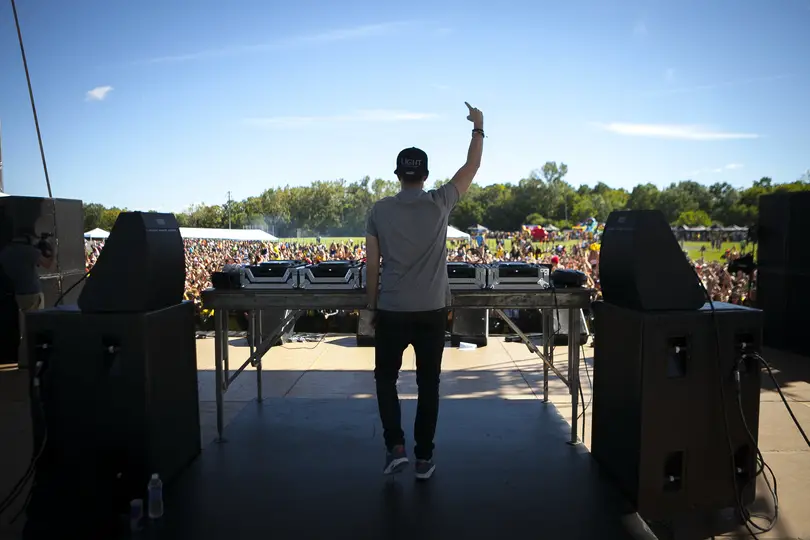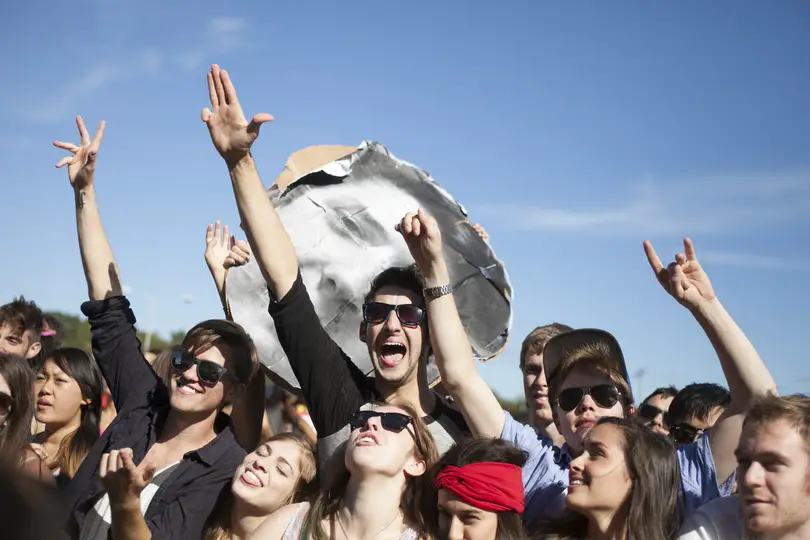Jam-packed: Juice Jam draws large crowd with first-ever festival format
Juice Jam 2013 was a tale of two stages.
The main stage was the one concertgoers have grown accustomed to seeing at Juice Jam: the behemoth backed by a video screen and sandwiched between two columns of speakers. Dwarfed in its shadow was the indie stage, a venue electronic artist Robert DeLong referred to as “this little trailer thing.”
The indie stage wasn’t quite as grand as the main stage, but stationed a few hundred feet away and with an American flag flapping breezily off to its side, it was noticeable if not monolithic.
But when Skytop Field opened not long after noon, Juice Jam might still have been a one-stage show. Students sporting overpowering shades of neon congregated at the main stage barrier, and it wasn’t until after University Union concert director Kelly Benini reminded them that indie rockers Smallpools were opening on the indie stage that half the crowd split for the smaller stage.
The band played through a set that featured several overhead handclaps, an impromptu arrangement of “Happy Birthday” for drummer Beau Kuther, and a cover of New Radical’s one-hit wonder “You Get What You Give.”
“The New Radicals broke up at the height of that song’s success,” Smallpools guitarist Mike Kamerman said with a laugh. “I feel like we’ve played it more times live than they had.”
The Juice Jam Music Festival was the first official concert Smallpools ever booked, and Kamerman joked that the band felt like their stint as the first act on the indie stage made them the concert’s guinea pigs.
Bundled up in black hoodies, The Neighbourhood broke in the main stage with a steady stream of fuzzy atmospheric guitars and moody vocals. Lead singer Jesse Rutherford, who describes The Neighbourhood’s style as “nighttime music,” said the band tinkered with its setlist to match the festival’s vibe.
“If we have a song that’s more of a daytime song that we don’t usually play, we’ll play it for something like this,” he said.
The Neighbourhood capped off their set with “Sweater Weather,” the linchpin single that’s been the springboard for the band’s recently-found success.
“I came to Juice Jam for The Neighbourhood more than Kendrick or Nicky Romero,” said junior fashion design major Hannah Gessler. “‘Sweater Weather’ was awesome.”
Hip-hop artist Ab-Soul rallied fans back to the indie stage, unleashing a frenetic set frequented by blaring hype horns. After, students tracked back over the few hundred feet between stages for DJ Nicky Romero’s set, a great migration that reduced Skytop Field to mud under the constant movement of sneakers and Sperry Topsiders.
But students like junior communication and rhetorical studies major Nancy Oganezov had no problem with making the trek. She said she’d like to see Juice Jam expand its stage count for upcoming concerts.
“It feels like a festival with the field, and it would be cool to walk around to different stages instead of just the two,” Oganezov said.
When Romero performed, he condensed his stage antic to fist pumps and rallying cries aimed at his rapidly expanding audience. Crowd surfers crested atop a sea of waving hands as the DJ spun remixes of pop hits like Bruno Mars’ “Locked Out of Heaven” while splicing in oldies-but-goodies, including Nirvana’s “Smells Like Teen Spirit.”
Though rain has woven itself into Juice Jam’s history, the only thing falling during the concert was giant white balloons heaved from the stage during Romero’s set. When the DJ rounded off his performance, the crowd thinned and ranks of tired concertgoers slumped onto the grass to rest.
They got back up when face-painted Robert DeLong started mixing beats from the indie stage. Hunched over his laptop with a microphone in one hand, DeLong polished off the stage in a performance bookended by Romero and headliner Kendrick Lamar.
“When I play in Europe, I play more house-based music,” DeLong said. “And if I do anything here that’s vaguely dubstep, people get pumped up.”
That might explain why the crowd hit a Lamar-mania fever pitch once DeLong wrapped up his set. Headliner Lamar walked onto the stage, clad in a plain grey hoodie, acting like a conductor to a symphony of hype horns, instructing his crowd to throw their hands up and wave.
He opened with energetic “M.A.A.D City” before pausing to acknowledge the audience’s cheers with an outstretched arm and cocky grin.
Goading the crowd to earn the title of “livest crowd” on his current tour, Lamar launched into a rapid-fire series of album cuts, guest verses, including his part on A$AP Rocky’s “F**king Problems,” and mixtape tracks. When he wasn’t rapping, he was busy shoehorning in transitions between songs.
“If you go home happy after this, your vibe won’t be killed,” Lamar said before rapping hit “B*tch, Don’t Kill My Vibe.”
After storming through fan favorites like “Poetic Justice” and “Swimming Pools (Drank),” Lamar burst into an a cappella freestyle before leaving his DJ behind onstage to encourage the crowd to demand an encore from the Compton rapper, who gladly obliged, rousing the crowd once more before vacating the main stage for good.
Two stages, three completely different acts on each, but the same result: for students like senior mechanical engineering major Matt Daddi, the festival format trumped Juice Jams of years gone by.
Said Daddi: “This is my fourth Juice Jam, and it’s the best one so far.”
Published on September 9, 2013 at 1:53 am
Contact Erik: [email protected] | @therealvandyman






